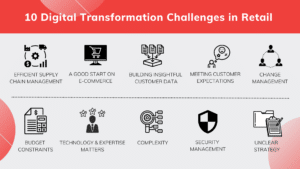We are living in an era where people from all walks of life keep scrolling through their smartphones, irrespective of what generation they belong to. COVID-19 pulled the curtains down over the bustling of the high street from the excitement of shopping sprees as restrictions still prevail in many countries, and COVID-19 has also brought clutter to our screens!
According to eMarketer, 2020 witnessed +27.6% growth in global online retail e-commerce, despite the overall retail industry’s 3% shrink. So, what does this mean to retailers? Surely, it’s time to gear up for digital transformation.
Digital transformation in retail is not just about e-commerce apps or websites. It’s about infusing technology into all aspects of the business. Digital transformation in the retail sector is pioneered by the adoption of technological advancements in the likes of IoT, facial recognition, warehouse & delivery robots, virtual store assistants, chatbots, cashier-less stores, e-wallets, augmented shopping, voice commerce, automated checkouts, smart shelves, etc. In this article, let’s look at the challenges retailers face during their digital transformation journey.
With an increasing number of shoppers looking for a wider range of buying options, there is a need for retailers to rethink their existing models in order to stay in the game. Moreover, globally, the Covid-19 outbreak is accelerating the adoption of digital services and creating new opportunities for retailers to step up their game.
However, starting on digital transformation for retailers is not always straight-forward and as a business, you will face several challenges, as listed below.

1. Top 10 digital transformation challenges in retail
1.1. Efficient supply chain management
As online buying soars with retailers adopting digital transformation, capacity handling becomes a challenge. Supply chains should be designed in a way that they can accommodate both temporary influxes as well as sustained growth.
Increasing customer expectations mean a reduction in the delivery time is necessary. If these demands are not consistently met by the supply chain setup there is a risk of getting left behind the competition. Countries are encountering the long-lasting effects of the pandemic supply chain disruptions in the form of delays, product shortages, and challenges on warehouse maintenance.
The retailers featuring omnichannel experiences in their services have to integrate e-commerce fulfillment with traditional distribution and that’s when things start to get complicated. So, unifying multiple inputs should be a priority when managing the supply chains.

1.2. A good start on e-commerce
Digitalization is the go-to solution that many turn towards to catch up with the fast changing market. In most cases, the first step is to move the commerce online, building online platforms and apps. The advent of the pandemic has propelled the need for this even further.
With e-commerce, retailers must get it right in terms of creating positive interactions with customers. Getting an interactive platform that is fast & secure with functional features, search options, optimized across several devices including mobile phones. There are several e-commerce platforms available in the market that reduce the efforts needed on the technical front, so there are no excuses for a bad website or a platform.
However, smaller retailers that are not yet ready to invest in building platforms could get onto social selling or local e-commerce platforms.

1.3. Building insightful customer data
Customers from all channels expect a great personalized experience when shopping, and it’s critical for businesses that they manage the database correctly to extract valuable insights from their customers and deliver the best experiences.
Capturing a large amount of information is important, but the more challenging part comes when it is time to define how to monitor, analyze and structure the acquired data from every interaction. Retailers need to end up with a meaningful database enabling them to effectively track trends and get deeper insights. It helps both sellers and customers when their information is managed conveniently. On the other hand, incorrect data can mislead the customers and negatively affect their experiences.

1.4. Meeting customer expectations
As ecommerce spikes and retailers focus on the omnichannel shopping experience, customers’ expectations are also growing higher. Gravy Analytics estimated that 90% of today’s consumers expect seamless interactions across all shopping channels, from in-store to websites to apps. This is where the omnichannel strategy has to thrive, as consistency in customers’ shopping experiences is vital in the age of digitalization.
Consequently, retailers need to create positive interactions with customers to better understand their demands and experiences, and from there, effectively optimize the platforms to meet customers’ expectations.

1.5. Change management
Digital transformation can come hand in hand with resistance to change from the people and departments that are used to certain ways to handle their touchpoints.
Concerns over the change of roles & KPIs and the doubts about the problems transformation programs might run into come as digital transformation cuts into traditional approaches. Defining ownership and discovering ways to measure the ROIs has become the new task. Leaders must address these challenges and break the status quo.
The mindset of not changing or not questioning change unless there is a crisis, can be dangerous in the context of effective digital transformation. People tend to realize the fast-changing market environment once it gets too late. So again, it all comes down to how leaders communicate using good reasoning and paint transformation as the vision of the future.

1.6. Budget constraints
As Retailers set themselves up for modernization with digital transformation, it puts a strain on budgets. This will be an ongoing process, and costs always recur.
To roll out the plans effectively, the initiatives from the management must be transformational enough, not just in terms of ideas but also with budgets. For many retail companies, digital transformation ends with a mobile app or website. To create un-compromised customer experiences and to reap the benefits of digital transformation, retailers should look at a comprehensive implementation that features AI-powered bots, AR/VR options, headless commerce, mobile POS, interactive kiosks, etc. Proper planning and allocation of budgets become vital.

1.7. Technology & expertise matters
Technologies play a key role in a successful transformation and the foundation needs to be robust. Combining the right set of technologies with a proper understanding and risk evaluation, is the biggest challenge. Analyzing available options and picking the right infrastructure and technologies that bring value, will remain the key.
In today’s market, numerous development teams and companies are competing to stand out. Yet, it can be a struggle for retailers to find themselves the right partner who can co-establish decent digital experiences for their customers, as well as ensure smooth operations for the business.
Therefore, it is of the utmost importance that retailers team up with compatible expert developers to reap the long run benefits of the chosen technologies.

1.8. Complexity
A majority of people are familiar with simple technology and digital platforms such as social media and mobile shopping apps, but that doesn’t mean they are capable of digitizing all aspects of their businesses with ease. Digital transformation requires a mixed skill set that those with little to no expertise can’t properly handle.
The complexity lies in the overwhelming number of details, steps, and processes required when going full digital, as well as keeping things unified across various channels while constantly updating the resources with the ever-changing technologies.
Oftentimes, retailers rely on outsourcing to develop efficient digital systems in a short amount of time while remaining professional.

1.9. Security management
The need to quickly upgrade and expand digital infrastructures comes with great concerns of cybersecurity. Particularly for the retail industry, which involves selling and buying in every single transaction, the platforms are exposed to risks of information getting stolen. This would be a huge setback for retailers who are putting effort into creating a safe and secured service made to facilitate easy management of their business.
A study by Fortinet revealed that 30% of retailers lost critical data due to cyberattacks. Cybercriminals and security gaps should therefore be prevented and tackled effectively by excelling at risk management and instant response when it comes to digital transformation on a large scale.

1.10. Unclear strategy
For achieving proper digital transformation, you need a well-defined strategy with clear objectives, goals, and vision. It has a lot to do with proper planning by the organizational management. The inputs have to be taken from everyone for a unified understanding from several touchpoints.
Business leaders should understand that digital transformation is not just about technologies. It’s constituted of business processes, self-awareness, competitor threats, new roles, organizational changes, and business models. So, an unclear digital strategy can be a fast-approaching pitfall when embarking on a digital transformation journey.

2. Conclusion
The Bloomberg intelligence report states that “digital’’ is expected to engulf 35% of the total retail sales in the United States, and the South East Asian markets are catching up fast thanks to smartphones (m-commerce) and COVID-19 restrictions.
Businesses need to be aware of the constantly evolving trends to successfully implement and prepare themselves to efficiently drive the transformation tasks. Many retail brands around the globe have reached new heights by shifting focus to technology and agile practices across key areas of their business.
Digital technologies are influencing customers’ expectations as well while the ever-chaining new normals are disrupting the retail industry. To remain relevant and become successful, retailers must embrace and swiftly respond to change by creating new experiences that add value for customers.

Kyanon Digital is a Vietnam-based technology power-house with specialist expertise in helping retail clients digitize their customer experiences and stay on top of trends. Check out our capabilities by browsing through our website and drop us a message to discuss how to effectively plan and kickstart the digital transformation of your retail business.


